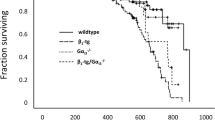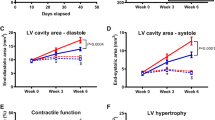Abstract
The muscle Lim protein knock-out (MLP-KO) mouse model is extensively used for studying the pathophysiology of dilated cardiomyopathy. However, explanation is lacking for the observed long survival of the diseased mice which develop until adulthood despite the gene defect, which theoretically predestines them to early death due to heart failure. We hypothesized that adaptive changes of cardiac intracellular calcium (Ca 2+i ) handling might explain the phenomenon. In order to study the progression of changes in cardiac function and Ca 2+i cycling, myocardial Ca 2+i -transients recorded by Indo-1 surface fluorometry were assessed with concomitant measurement of hemodynamic performance in isolated Langendorff-perfused hearts of 3- and 9-month old MLP-KO animals. Hearts were challenged with β-agonist isoproterenol and the sarcoplasmic reticular Ca2+-ATPase (SERCA2a) inhibitor cyclopiazonic acid (CPA). Cardiac mRNA content and levels of key Ca2+ handling proteins were also measured. A decline in lusitropic function was observed in 3-month old, but not in 9-month old MLP-KO mice under unchallenged conditions. β-adrenergic responses to isoproterenol were similar in all the studied groups. The CPA induced an increase in end-diastolic Ca 2+i -level and a decrease in Ca2+-sequestration capacity in 3-month old MLP-KO mice compared to age-matched controls. This unfavorable condition was absent at 9 months of age. SERCA2a expression was lower in 3-month old MLP-KO than in the corresponding controls and in 9-month old MLP-KO hearts. Our results show time-related recovery of hemodynamic function and an age-dependent compensatory upregulation of Ca 2+i handling in hearts of MLP-KO mice, which most likely involve the normalization of the expression of SERCA2a in the affected hearts.






Similar content being viewed by others
References
Sipido KR, Eisner D (2005) Something old, something new: changing views on the cellular mechanisms of heart failure. Cardiovasc Res 68:167–174
Linck B, Boknik P, Baba HA, Eschenhagen T, Haverkamp U, Jackel E, Jones LR, Kirchhefer U, Knapp J, Laer S, Müller FU, Schmitz W, Scholz H, Syska A, Vahlensieck U, Neumann J (1998) Long-term beta adrenoceptor-mediated alteration in contractility and expression of phospholamban and sarcoplasmic reticulum Ca2+-ATPase in mammalian ventricle. J Pharmacol Exp Ther 286:531–538
Boluyt MO, Robinson KG, Meredith AL, Sen S, Lakatta EG, Crow MT, Brooks WW, Conrad CH, Bing OHL (2005) Heart failure after long-term supravalvular aortic constriction in rats. Am J Hypertens 18:202–212
Pogwizd SM, Qi M, Yuan W, Samarel AM, Bers DM (1999) Upregulation of Na+/Ca2+ exchanger expression and function in an arrhythmogenic rabbit model of heart failure. Circ Res 85:1009–1019
Arber S, Hunter JJ, Ross J Jr, Hongo M, Sansig G, Borg J, Perriard JC, Chien KR, Caroni P (1997) MLP-deficient mice exhibit a disruption of cardiac cytoarchitectual organization, dilated cardiomyopathy, and heart failure. Cell 88:393–403
Bos JM, Poley NP, Ny M, Tester DJ, Xu X, Vatta M, Towbin JA, Gersh BJ, Ommen SR, Ackerman MJ (2006) Genotype-phenotype relationships involving hypertrophic cardiomyopathy-associated mutations in titin, muscle LIM protein and telethonin. Mol Genet Metab 88:78–85
Esposito G, Santana LF, Dilly K, Crus JD, Mao L, Lederer WJ, Rockman HA (2000) Cellular and functional defects in a mouse model of heart failure. Am J Physiol Heart Circ Physiol 279(6):H3101–H3311
Minamisawa S, Hoshijima M, Chu G, Ward CA, Frank K, Gu Y, Martone ME, Wang Y, Ross J, Kranias EG, Giles WR, Chien KR (1999) Chronic phospholamban-sarcoplasmic reticulum calcium ATPase interaction is the critical calcium cycling defect in dilated cardiomyopathy. Cell 99:313–322
Lorenzen-Schmidt I, Stuyvers BD, Keurster HEDJ, Date M, Hoshijima M, Chien KR, McCulloch AD, Omens JH (2005) Young MLP deficient mice show diastolic dysfunction before the onset of dilated cardiomyopathy. J Mol Cell Cardiol 39:241–250
Omens JH, Usyk TP, Li Z, McCulloch AD (2002) Muscle LIM protein deficiency leads to alterations in passive ventricular mechanics. Am J Physiol Heart Circ Physiol 282:H680–H687
Antoons G, Vangheluwe P, Volders PGA, Bito V, Holemans P, Ceci M, Wuytack F, Caroni P, Mubagwa K, Sipido KR (2006) Increased phospholamban phosphorylation limits the force-frequency response in the MLP−/− mouse with heart failure. J Mol Cell Cardiol 40:350–360
Su Z, Yao A, Zubair I, Sugishita K, Ritter M, Li F, Hunter JJ, Chien KR, Barry WH (2001) Effects of deletion of muscle LIM protein on myocyte function. Am J Physiol Heart Circ Physiol 280(6):H2665–H2673
Costandi PN, Frank LR, McCulloch AD, Omens JH (2006) Role of diastolic properties in the transition to failure in a mouse model of the cardiac dilatation. Am J Physiol Heart Circ Physiol 291:H2971–H2979
Ivanics T, Miklos Z, Dezsi L, Ikrenyi K, Toth A, Roemen TH, Van der Vusse GJ, Ligeti L (2001) Concomitant accumulation of intracellular free calcium and arachidonic acid in the ischemic-reperfused rat heart. Mol Cell Biochem 226(1–2):119–128
Op den Buijs J, Miklos Z, van Riel NAW, Prestia CM, Szenczi O, Tóth A, Van der Vusse GJ, Ligeti L, Ivanics T (2002) Beta-adrenergic activation reveals impaired cardiac calcium handling at early stage of diabetes. Life Sci 76:1083–1098
Op den Buijs J, Ligeti L, Ivanics T, Miklos Z, Van der Vusse GJ, Van Riel NAW (2008) Mathematical modelling of the calcium–left ventricular pressure relationship in the intact diabetic rat heart. Acta Physiol 193:205–217
Grynkiewicz G, Poenie M, Tsien RY (1985) A new generation of Ca2+ indicators with greatly improved fluorescence properties. J Biol Chem 260(6):3440–3450
Bassani JW, Bassani RA, Bers DM (1995) Calibration of indo-1 and resting intracellular [Ca2+]i in intact rabbit cardiac myocytes. Biophys J 68(4):1453–1460
Bodó E, Bíró T, Telek A, Czifra G, Griger Z, Tóth IB, Mescalchin A, Ito T, Bettermann A, Kovács L, Paus R (2005) A “hot” new twist to hair biology—involvement of vanilloid receptor-1 (VR1/TRPV1) signaling in human hair growth control. Am J Pathol 166(4):985–998
Fülöp L, Bányász T, Szabó G, Tóth IB, Bíró T, Lőrincz I, Balogh Á, Pető K, Mikó I, Nánási PP (2006) Effect of sex hormones on ECG parameters and expression of cardiac ion channels in dogs. Acta Physiol (Oxf) 188(3–4):163–171
Van der Velden J, Papp Z, Boontje NM, Zaremba R, de Jong JW, Janssen PML, Hasenfuss G, Stienen GLM (2003) The effect of myosin light chain 2 dephosphorylation on Ca2+-sensitivity of force is enhanced in failing human hearts. Cardiovasc Res 57:505–514
Qi MY, Feng Y, Dai DZ, Li N, Cheng YS, Dai Y (2010) CPU86017, a berberine derivative, attenuates cardiac failure through normalizing calcium leakage and downregulated phospholamban and exerting antioxidant activity. Acta Pharmacol Sin 31(2):165–174
Kiss E, Ball NA, Kranias EG, Walsh RA (1995) Differential changes in cardiac phospholamban and sarcoplasmic reticular Ca2+-ATPase protein levels. Effects on Ca2+ transport and mechanics in compensated pressure-overload hypertrophy and congestive heart failure. Circ Res 77:759–764
Davidson MJ, Koch WJ (2001) Genetic manipulation of β-adrenergic signalling in heart failure. Acta Physiol Scand 173:145–150
Rockman HA, Chien KR, Choi DJ, Iaccarino G, Hunter JJ, Ross JJ, Lefkowitz RJ, Koch WJ (1998) Expression of a beta-adrenergic receptor kinase 1 inhibitor prevents the development of myocardial failure in gene-targeted mice. Proc Natl Acad Sci USA 95:7000–7005
Van den Bosch BJC, van den Burg CMM, Schoonderwoerd K, Lindsey PJ, Scholte HR, de Coo RFM, van Rooij E, Rockman HA, Doevendans PA, Smeets HJM (2005) Regional absence of mitochondria causing energy depletion in the myocardium of muscle LIM protein knockout mice. Cardiovasc Res 65:411–418
Acknowledgments
The authors acknowledge the excellent technical assistance of Margit Kerék and Judit Fábián. This study was supported by grants from OTKA (K61694 and F68502), Hungary.
Author information
Authors and Affiliations
Corresponding author
Additional information
László Ligeti—deceased.
Rights and permissions
About this article
Cite this article
Kemecsei, P., Miklós, Z., Bíró, T. et al. Hearts of surviving MLP-KO mice show transient changes of intracellular calcium handling. Mol Cell Biochem 342, 251–260 (2010). https://doi.org/10.1007/s11010-010-0492-8
Received:
Accepted:
Published:
Issue Date:
DOI: https://doi.org/10.1007/s11010-010-0492-8




